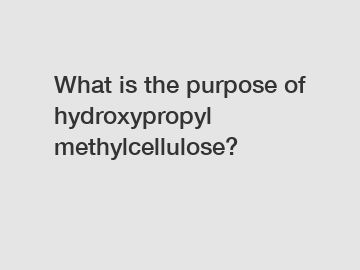Dec. 28, 2023
Chemicals
You will get efficient and thoughtful service from AiBeiDe.
What is the Purpose of Hydroxypropyl Methylcellulose?
Hydroxypropyl Methylcellulose (HPMC) is a versatile compound used in various industries for a wide range of applications. Derived from cellulose, a natural polymer found in plants, HPMC has found its place in many products due to its unique properties. In this article, we will explore the purpose of hydroxypropyl methylcellulose and its uses in different industries and sectors.

Understanding Hydroxypropyl Methylcellulose.
Before delving into its purpose, it's important to grasp what hydroxypropyl methylcellulose actually is. HPMC is a chemically modified cellulose ether, made by substituting some of the hydroxyl groups of cellulose with hydroxypropyl and methyl groups. This substitution enhances the compound's water retention capabilities, gelation, thickening, and film-forming properties. Due to these characteristics, HPMC has become an essential ingredient in numerous applications across industries.
1. Construction Industry Use.
One significant purpose of hydroxypropyl methylcellulose is in the construction industry. HPMC is commonly used in cement-based materials, such as mortar and plaster, to improve their workability and performance. The compound acts as a thickener and water retention agent, allowing for improved adhesion, increased open time, and reduced sagging of the material. Additionally, it helps reduce cracking, enhance durability, and provide better resistance to water penetration.
2. Pharmaceutical and Personal Care Products.
Another important application of hydroxypropyl methylcellulose is in pharmaceutical and personal care products. It serves as a matrix former and film former in oral solid dosage forms such as tablets and capsules. HPMC provides improved drug release, bioavailability, and stability of medicines. Additionally, it is used as a suspending agent in liquid dosage forms such as syrups and suspensions. In personal care products, HPMC functions as a thickening agent, emulsifier, and moisturizing agent in various creams, lotions, and gels.
Suggested reading:3. Food and Beverage Industry.
Hydroxypropyl methylcellulose has found its way into the food and beverage industry as well. It is used as a food additive, primarily as a thickening and stabilizing agent. HPMC can improve the texture, consistency, and shelf life of food products. It is commonly used in sauces, dressings, bakery goods, and dairy products. Due to its non-toxic nature, HPMC is considered safe for consumption.
4. Other Industries and Applications.
HPMC also finds application in various other industries. In the paint and coating industry, it acts as a thickener and binder, improving paint adhesion and viscosity control. In the textile industry, HPMC is used as a sizing agent, providing temporary support to yarns during weaving. It is also used as a protective colloid and emulsion stabilizer in the production of synthetic latex. Due to its chemical compatibility and film-forming properties, HPMC is widely used in various adhesive formulations.
Conclusion.
In conclusion, hydroxypropyl methylcellulose serves a multitude of purposes in different industries and sectors. Whether it's improving the workability of construction materials, enhancing drug release in pharmaceuticals, providing texture and stability in food products, or acting as a binder in paints and adhesives, HPMC has established its importance. Its versatile nature and unique properties make it an invaluable compound across various applications.
If you want to explore the uses and benefits of hydroxypropyl methylcellulose in your specific industry, feel free to contact us. Our experts are ready to assist you in finding the most suitable solutions and answer any queries you may have.
Click here to get more.
For more information, please visit hpmc powder factory.
Suggested reading:Previous: Which Compostable Bags Are the Best?
Related Articles
If you are interested in sending in a Guest Blogger Submission,welcome to write for us!
All Comments ( 0 )